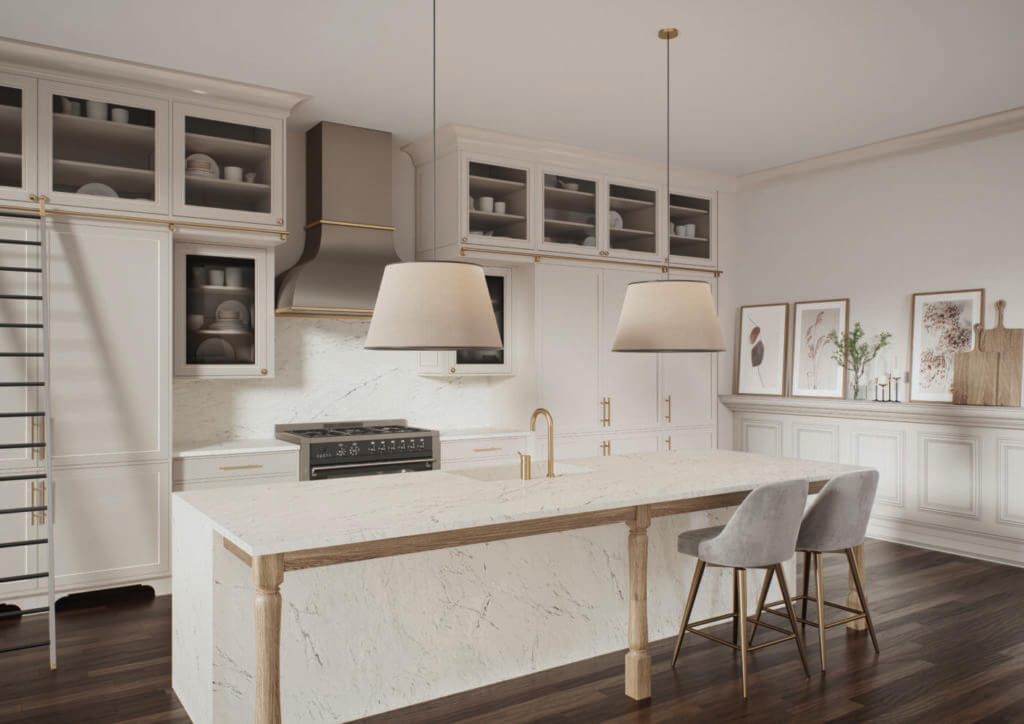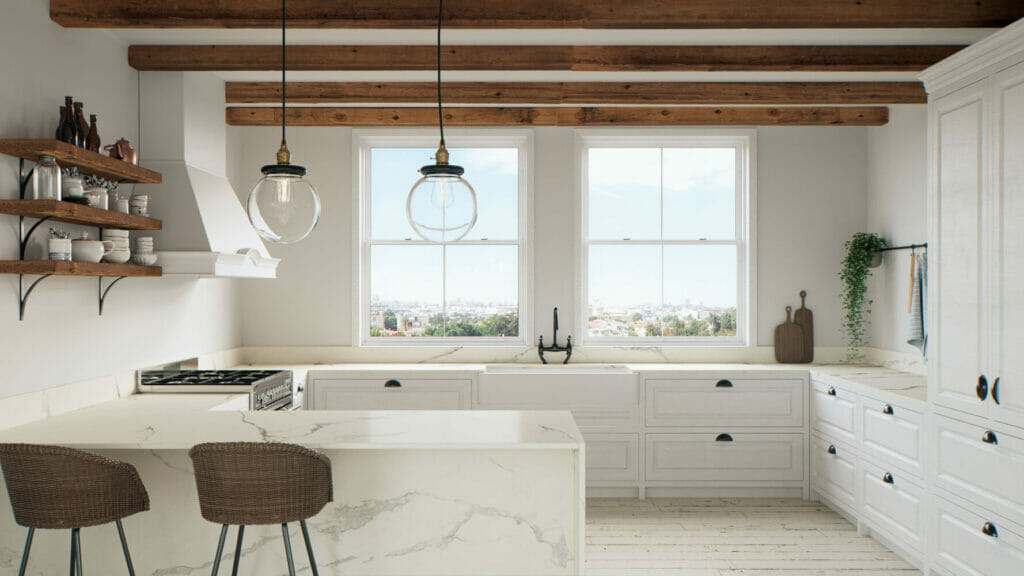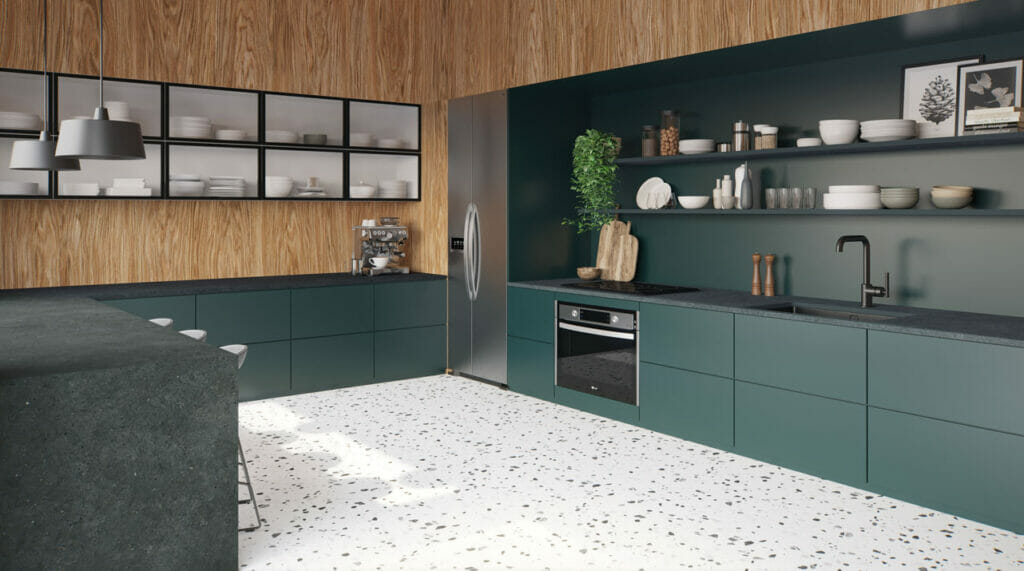Porcelain Countertop Colors: Modern Trends
6 min read
Porcelain is gaining intense popularity, becoming an easy choice for kitchen and bathroom countertops. Aside from its durability, strength, heat, stain, and water-resistant properties, it has amassed a cult following because of its versatility.
Porcelain, with its wide range of colors and patterns, provides homeowners with the flexibility to design according to their personal style and vision. However, modern trends have been favoring a specific set of colors for porcelain countertops.

Porcelain is a man-made ceramic made from a mix of quartz, clay, and feldspar. These ingredients are all blended together under extreme heat to create the engineered stone.
Porcelain countertops are best suited in spaces such as kitchens and bathrooms but are also a fantastic addition to laundry rooms. Because of its heat and stain-resistant properties, the material is safe to use in these settings.
Additionally, porcelain is one of the few countertop materials that is safe to use outdoors. Because it can withstand sun exposure, the colors won’t fade, even when used in backyards and gardens.
There’s no denying that porcelain is a versatile material that works well in kitchens and bathrooms. Homeowners that are looking for some inspiration can learn about the latest design trends below:
The most common colors used for porcelain countertops are white and neutral beige. They’re like blank slates that make the countertop surface a perfect addition to a kitchen or bathroom, regardless of the interior design.
In a kitchen, a light-colored porcelain countertop, like Caesarstone’s 531 Libretta, looks calming and serves as a clean focal point. In bathrooms, it helps keep the space bright and welcoming.
Some homeowners aren’t afraid to use darker porcelain colors like navy blue, black, or deep gray. These colors exude a timeless, sophisticated look and work best in modern, minimalist kitchens.
Dark porcelain, like Caesarstone’s 220 Magnate, can be an excellent choice for creating a deep, dramatic-looking space or for providing contrast with lighter interior elements. Regardless, dark porcelain is an exquisite addition to any home.
Porcelain’s versatility allows homeowners to go bold with their countertop color choice. From dark burgundies to stark browns, a porcelain countertop can make for a fascinating focal point in a space.
In a bathroom, bold porcelain countertops, like Caesarstone’s 511 Smokestone, are best paired with neutral-colored cabinetry, hardware, and flooring. Opting for neutrally-colored decor makes the countertop the most eye-catching piece in the room.
It might be challenging to visualize how a bold countertop will look in a kitchen or bathroom. Homeowners can use Caesarstone’s 3D visualizer and see for themselves.
Homeowners should consider adding details and patterns to their countertops. Whether it’s complementary veining or eye-catching patterns, these small details can change a porcelain countertop’s overall look.
Detailed porcelain countertops, like Caesarstone’s 503 Circa, look fantastic in both kitchens and bathrooms; however, homeowners should try to keep décor to a minimum to bring out the beautiful details of the color and pattern, enhancing the overall aesthetic of the space.

Porcelain’s fabrication process and components give the material several properties that make them beneficial for countertop use. These benefits include:
Porcelain is 30% more durable than other natural stone materials. The material goes through a firing process under extreme heat, which makes it strong and resistant to various forms of damage.
Porcelain can withstand hot pans and pots on its surface without smoking, burning, or emitting any chemicals or harmful substances. This resistance makes porcelain a very sought-after material when crafting kitchen countertops.
Porcelain is non-porous, meaning its components are so tightly packed that water and air cannot penetrate the surface. Boasting a water absorption rate of 0.5%, porcelain is extremely resistant to spills. Porcelain countertops are the perfect option for kitchens and bathrooms that use a lot of water, and homeowners can stay confident that they won’t damage their countertop’s surface.
In addition to its non-porous nature, porcelain also possesses excellent stain resistance properties. Because it doesn’t absorb liquids, homeowners need not worry about wine, colored liquids, or other acidic substances staining the surface.
Porcelain is man-made, which means it can be customized with different colors, patterns, and finishes. From natural colors to darker hues, the options are limitless when it comes to porcelain countertops.
Porcelain can be cut in larger sizes than other materials, which is excellent news for homeowners who want large installations. Natural stones are limited in size and only come in smaller slabs, meaning two or more pieces must be connected to fit a large counter. That’s not the case for porcelain, where only one piece is needed for a single installation. This increased size offering allows for larger installations with potential for less seams.
Porcelain is generally cut into thin slabs, which makes it lightweight and easy to install. There are slabs as thin as 3/16”, allowing for installation atop an existing countertop with no problems.
Because of porcelain’s properties, it’s quite easy to maintain. Cleaning only requires a damp cloth and soapy water, and spills are generally easy to remove without intense scrubbing.
It’s worth noting that harsh chemicals should not be used with porcelain to maintain its condition. Although the material is resistant to harsh substances, there’s no need to use them to clean porcelain.

Porcelain countertops can come in various colors and styles to suit different personalities and preferences. Modern trends are leaning toward more diverse styles, whether that means having a light-colored countertop that suits a bright kitchen or a dark installation for a sophisticated bathroom.
Regardless, the best countertop color is whatever suits the personal style of the homeowner. Order a sample to try different porcelain countertop colors and find the best one for the intended space.
{{ subtitle }}
{{ i.desc }}
{{ subtitle }}
{{ subtitle }}